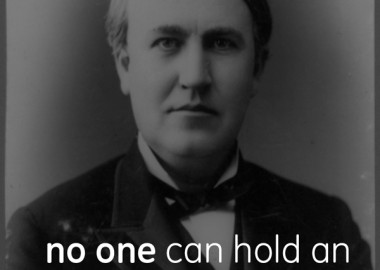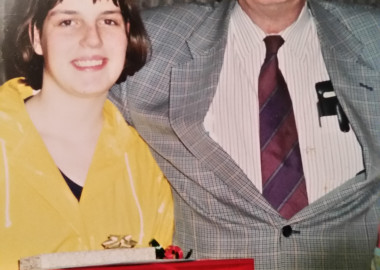
Whether or not you consciously think about the origin stories of brands or admirable leaders, you probably know a slew of them.
Nike’s Phil Knight started out by selling shoes out of the back of his car at track meets.
Sara Blakely first got her $250-million product, Spanx, in stores by demonstrating them herself to store buyers while wearing a pair of form-fitting white pants.
Oprah Winfrey overcame sexual abuse and poverty to build a $4 billion media empire.
Richard Branson was a high school dropout who started Virgin Records as a mail order record company.
J.K. Rowling wrote Harry Potter at coffee shops, while struggling as a single mom to make ends meet.
Apple was started in a garage, based on the friendship between Steve Wozniak and Steve Jobs.
Socially conscious Ben & Jerry’s began when childhood friends Ben Cohen and Jerry Greenfield took a correspondence course on ice cream making.
Warren Buffet started out as an entrepreneur by buying pinball machines, and saving up the revenue he got by placing them in local shops.
Why Your Origin Story Matters
As humans, we love and crave narrative. We’re curious beings. And we want nothing more than to relate to others.
Most of us come from humble beginnings, and we love it when successful people and brands—not to mention superheroes—reveal theirs, too. It makes us feel a little bit better that Superman was raised by two normal parents on a farm, and that Clark Kent is treated like a bit of a geek.
We also love photos like the one below, of Amazon’s Jeff Bezos in 1999.

Most of us have been sitting at a desk like Bezos’ at one time or another. And like Clark Kent, we know what it’s like to be dismissed, and yet to feel like there’s something greater hidden inside us. We know what it’s like to imagine bigger things.
You probably know from experience that you trust people more when you know a little of their past, and what drives them. Why not try it yourself? Be forthcoming about the real reasons you started doing what you’re doing, and about the lessons you learned along the way. People and brands are far from perfect. Own that imperfection.
How to Tell a Good Origin Story
Keep the story real.
I really like this story about Buffer’s origins, as penned by founder Joel Gascogne. Sure, the piece could use a good edit (to save you some time, it comes down to “I wanted to make scheduling tweets ‘x times a day’ as easy as tweeting regularly”). But the important thing is that Gascogne’s concern for his audience sounds real and true. The guy’s not trying to save the world, but rather to solve an annoying problem for his target audience. And those who work with social media scheduling thank him.

Tell the truth, for heaven’s sake.
Compare the Buffer example with a misstep from eBay in the 1990s.
There’s a story going around that eBay founder Pierre Omidyar came up with the idea for eBay because he wanted to help his girlfriend more easily buy, sell, and trade the classic Pez candy dispensers she liked to collect. The story continues to persist, but isn’t true; the narrative was manufactured by Mary Lou Song, an eBay employee who realized that the real story wasn’t clear, compelling, or resonating with early customers.
According to Adam Cohen’s book The Perfect Store: Inside eBay, the real story was that Omidyar had posted a broken laser pointer for sale online, saw it go for $14, and concluded there was an opportunity to create a profitable marketplace. There’s clearly a difference in the quality of the story: Omidyar as a sweet boyfriend helping to ensure the survival of an American classic toy really is a better story than a crafty businessman interested in making a buck on crappy merchandise. But the truth matters too. And in the end the reputations of Omidyar–and of eBay–are a bit grimier as a result of the lie.
Answer tough questions.
Many of us—businesses included—are sitting on stories we don’t think of as good stories; they’re just things that happened to us. No big deal.
Not true. Those things matter to your employees, customers, and the people you do business with. Your stories provide evidence of your character. Your stories illustrate what you say you’re all about.
Thanks to years of experience in talking to individuals and families to craft memoirs, and business owners and stakeholders to get to the heart of brand and business stories, we can heartily recommend the practice of having someone else interview and record you to uncover and/or discover the stories you should share.
Give an interviewer the authority and responsibility to ask tough questions and record responses, and give yourself the authority and responsibility to answer truthfully, and vulnerably. In other words, if you’re looking for an authentic, interesting story, give yourself permission to go there. You’ll be rewarded.
Try questions like these to kickstart your own discovery process:
- What do you say now when people ask you how you started out as a brand or leader?
- What are you leaving out?
- Exactly what was it that first compelled you to do what you do? Has it changed? Why, and how?
- When was the last time you took a stand that cost you something?
- Who/what audience do you consider first when you make the big decisions about your brand or in your role?
- Just what gives you the right or chutzpah to do what you do? (Yep, get feisty. Now answer the question.)
Try these questions, too, to uncover a deeper brand story.
Know your audience.
A fundamental part of our story process here at ECHO — for every project we do — is the identification of audience. Why? Because good storytelling, by definition, requires the participation of an emotionally engaged audience. And if you want to tell the right story, in the right way, to emotionally connect with that audience, you’d better know who you’re talking to.
People care especially about things that affect them. It’s your job to figure out that those things are: what your audience loves, what they hate, what they’re afraid of, what their pain points are, what they want to become. And the way in? Get to know exactly who that audience is. The way we do it here is to identify target audiences, and in some cases, to also craft audience personas. The difference for us: personas tell a richer story about what a representative audience member wants and needs from you. A target audience, for example, will tell you that men between 50 and 65 are most likely to open your newsletter about personal storytelling. A persona will tell you that those men are interested in writing a memoir, but afraid of seeming vain in doing so, and looking for concrete advice on how to do it right. And it’s the persona that will guide you to share the story of how one man’s honest memoir brought him closer to his friends and family.
To understand your target audience, you can start with the basics: gather the demographic information you know about your audience’s age, gender, geographical location, professional/employment information, and education. For better or for worse, Google Analytics and social media sites like Facebook and LinkedIn are treasure troves for this data. Or try asking your customers, in person or via surveys.
To create personas, you can use the demographic information you’ve gathered, along with information about their goals, their challenges, their values, wants, and fears. This is trickier to gather, of course, but you can find out a lot about customers over a coffee or lunch with your most representative audience members.

Take it from the superheroes.
Regardless of audience, you’re decidedly not on your own when it comes to telling any story. We have thousands of years of evidence about the types of stories and plots and narrative techniques that work on humans of all varieties. We also have superheroes. Who all have origin stories, for better or worse. Here are a few things that many origin stories reveal:
- The hero had, and has, problems that regular people can understand and relate to.
- They usually respond to their new powers like a human would, demonstrating frailty, ego, and error.
- It’s clear at some point why they’re a hero — and it’s not always because of their powers.
- They’re not always serious.
And as Smithsonian Magazine’s Robin Rosenberg observes, those origin stories tend to “show us not how to become super but how to be heroes, choosing altruism over the pursuit of wealth and power … At their best, superhero origin stories inspire us and provide models of coping with adversity, finding meaning in loss and trauma, discovering our strengths and using them for good purpose. (Wearing a cape or tights is optional.)”
Isn’t that what you want to do as a leader?




